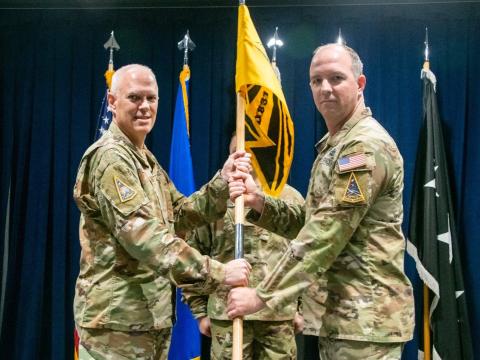Revolutionizing the Future of Mission Command
The process of upgrading command and control within the U.S. Army is taking a major step forward. Starting this month, leaders are expected to seek help from the private sector and award a contract for the construction of the branch’s Next-Generation Command and Control (NGC2) concept. Then, prototype deliveries will begin later this year in the fall, according to Col. Matthew Skaggs and Col. Michael Kaloostian, co-leaders of the NGC2 effort, Army Futures Command.
These developments come after NGC2 showcased its capabilities during several warfighter-run tests and assessments at Project Convergence Capstone 5 in Fort Irwin, California, in March. However, despite the concept’s success, officials observed a plethora of logistical abnormalities and concept components that still need to be addressed and improved, specifically within the realms of data transportation and storage and software-defined networking (SDN).
Firstly, a major lesson that leaders learned through NGC2 experimentation is that the process of finding an industry partner may be more uncommon than usual. Officials stressed that the contract they enter must be flexible and adaptable.
Due to the magnitude of the NGC2 project and its ever-changing nature, a single company should not be responsible for the entire system, according to Skaggs. Army officials want the freedom to experiment with several companies, observe the capabilities they offer, apply them to NGC2 and then either move forward with them or move on. In other words, they want to avoid being locked into a contract that gives a single company the reins to NGC2 development, which they fear could lead to a subpar product.
“The thing that’s different about NGC2 is that it’s more of a concept than a system in that we built a cloud-based architecture that’s on an integrated data layer,” Skaggs said in an interview with SIGNAL Media. “But we want to contract this in a way that we’re not locked into one big prime vendor, and they are in charge of the whole system. The data needs to be observable and extensible, and we need to have the ability—if an application isn’t working right—[to] go hire another company to bring a new application in.
Furthermore, NGC2 features a data extensibility capability that makes it easy for companies to apply their innovations to the system. Businesses can plug their new tools right onto the extensible data layer, according to Skaggs. This gives them a convenient method for testing their capabilities to see if they are a good fit for the NGC2 system.
The words “flexible” and “contract” could be used as antonyms, and they rarely go in the same sentence, so this experimentation-type agreement may be frustrating and arduous, but it is something that Skaggs called “probably the most critical part of this [project].”
“What we’re trying to undertake is a new way of cutting a contract that brings in a whole family of companies, a whole huge team of companies that is competitive in nature that brings us the best that technology has to give, but we have to be super creative with how we write those contracts to enable us—on the government side—flexibility and agility to move companies in and out as requirements change,” Skaggs said. “And if we can’t get that right, then we’re probably going to end up where we’ve always been with mission command systems. So, I think that’s what makes it special, but that’s probably the most critical part of this.”
Meanwhile, leaders say that several changes are needed to the NGC2 framework. Firstly, crews must build NGC2 to require low-latency data transport, a component that must be added to ensure that information sharing is as effective and efficient as possible. To accomplish this, officials are starting from their goal and working backward to find solutions to achieve their goal, according to Skaggs.
“We understand that we’re not going to always be able to get back to the edge and that there will be latency issues that we’ll have to work through,” Kaloostian said. “That’s the reason why edge compute becomes more and more important, because the data that we can ingest at the edge from sensors and the data that we can process to AI at the edge is data that is getting to the commander immediately and not being injected, or there’s no requirement to get back into the cloud in order to access that data.”
“We have to think about AI at the edge and making sure that we can ingest data, make sense of that data and that data can be used by lower-echelon commanders while in conflict,” Kaloostian added.
Additionally, officials are looking at increasing the privacy and security of the NGC2 system. Warfighters want to minimize or ideally eliminate their signature at times while using NGC2 on the battlefield to hide from sensors and radio frequencies launched by adversaries, according to Skaggs.
Finally, SDN was released in 2019 as a “network modernization approach that relocates and centralizes local network routing control functions at a secure remote location,” according to John Shotwell and Amy Walker, Program Executive Office Command, Control, Communications, and Network, formerly Program Executive Officer Command, Control, Communications–Tactical. And through NGC2 testing, Army officials noted that the SDN approach is not quick enough to ensure that warfighters are prepared. To fix this, leaders are proposing the introduction of an artificial intelligence-based solution to help improve its speed.
“Conflict in the future is going to move so fast, and there won’t be an opportunity for us as signal soldiers and signal leaders to be able to manipulate the network based on enemy conditions manually,” Kaloostian said. “We just won’t have the time to do that, so I do believe that we need to move AI into a space that it’s doing the network operations for us—that it is not only choosing best path for data, but it’s also thinking through and understanding what the enemy is trying to do to us in the battlespace, as well in the electromagnetic spectrum and reacting accordingly.”
“We’re going to transition to something that’s a completely autonomous, intelligent, threat-informed network,” Kaloostian added. “That is the goal. And I think that’s going to be the main requirement in the future in large-scale combat operations.”
The concept of NGC2 was created about 18 months ago to provide commanders with an improved information database that enables them to make better decisions more quickly, according to Maj. Gen. Patrick Ellis, director, Command and Control Cross-Functional Team. Additionally, NGC2 gives commanders a more mobile, convenient and accessible command and control system, according to Claire Heininger, communications director, Network Cross-Functional Team.
Ellis and Mark Kitz, program executive officer, Command, Control, Communications, and Network, elaborated on how they expect NGC2 to impact military operations.
“That’s the goal of this; that’s kind of the whole concept is we’re just going to empower commanders to make better, faster and more decisions,” Ellis said in an interview with SIGNAL Media. “And because of the way that we see the modern battlefield going, we have to get those tools in our commanders’ hands so that they can make good decisions.”
“This is a journey,” Kitz said. “Achieving a really robust, holistic, unified network for the Army is a journey. I think NGC2 is a huge milestone on achieving that journey and an undertaking that the Army has not done in the past. And I think everybody’s really excited about what the future of our network looks like.”





Comments